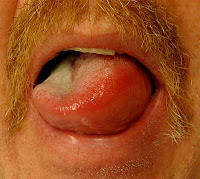Home > Symptoms and causes of rhinophyma - treatment of rhinophyma
Rhinophyma is the large, erythemic, bulbous, uneven swelling of the nose caused by the advanced-stage phymatous rosacea. It may affect any person with long-term untreated rosacea.
Rhinophyma is found to occur in middle-aged and elderly men, while it rarely occurs in women. The term rhinophyma is derived from the Greek words, 'rhis' meaning nose and 'phyma' meaning growth, swelling or bulb. It is predominantly found in people of English, Irish and Scottish descent.
The overgrowth (hypertrophy) of sebaceous glands of the tip of the nose can become unsightly and may even obstruct breathing and sight. The effect of rhinophyma disfigurement can leave a strong psychological impact on a patient’s self-esteem leading to depression.
The National Rosacea Society (NRS) has classified rhinophyma as subtype 3 phymatous rosacea. Phymatous rosacea has typical symptoms such as thickening skin, irregular surface nodularities and enlargement. Phymatous rosacea can occur on nose (rhinophyma), forehead (metophyma), ears (otophyma), chin (gnathophyma) and eyelids (blepharophyma).
Causes of rhinophyma
The exact cause and pathogenesis are unknown. The erythema of the nose is due to dilation of the superficial vasculature. The vascularization of the capillaries may cause atrophy of the papillary dermis. The superficial vascularization leads to increased blood flow and causes edema in the nose. Then the overgrowth of sebaceous glands (sebaceous hyperplasia) and fibroplasia follows.
Helicobacter pylori infection is associated with urticaria. Eradication of Helicobacter pylori, improved the phymatous rosacea symptoms. But as there is no total eradication of rosacea, the possibility of H.pylori being the cause remains uncertain.
Alcoholism can cause facial edema and swelling of the nose. But the swelling due to alcoholism or aging is usually even. However alcoholism can worsen the condition. The symptoms of rhinophyma are mistakenly connected to heavy alcohol consumption leading to delay in diagnosis and treatment.
Symptoms presented by rhinophyma
Symptoms of rhinophyma become apparent gradually. Initially there may be intermittent facial flushing. This may be mistaken for age related changes on the skin, sunburn or acne. With the disease progression, symptoms such as erythema and telangiectasias become apparent. This stage is followed by symptoms like skin thickening, fibroplasia and sebaceous hyperplasia of the skin. Typical symptom is the uneven swelling of the nose.
Rhinophyma treatment options
Rhinophyma is a condition that can be easily diagnosed and effectively treated in most patients. If the symptoms are diagnosed early, medication can help in alleviating the condition. Avoiding the triggers and treatment of its earliest manifestations can protect from its progression to later stages and fibrosis.
Medications
Topical metronidazole is the first-line treatment in the early stages. It can be applied in the form of cream or gel once or twice a day. For the patients having tender skin, sulfacetamide lotion may be used as it is less irritating.
Antibiotics like tetracycline, minocycline, doxycycline and clarithromycin have been effective in controlling rhinophyma, when used as simultaneous oral and topical treatments.
Anti-acne medications like topical azelaic acid, retinoic acid and retinaldehyde cream are also effective in controlling the early stages of rhinophyma.
In moderately advanced stages of rhinophyma, the treatment with oral isotretinoin has reduced the sebaceous glands growth and keratinization.
All these medications may have side effects which can be sometime serious. The treatment must be carried out only under the advice of your dermatologist.
Surgical treatment options
The surgery of rhinophyma consists of removing the excess growth. A wide range of surgical procedures is available.
Cryosurgery (cryotherapy) is used to apply extreme cold to destroy the abnormal rhinophyma growth. Freezing temperatures cause ice crystals to form inside the cells, tearing them apart.
Radiofrequency ablation (RFA) is a medical procedure in which a needle-like RFA probe is placed inside the bulbous mass and radiofrequency waves are passing through the probe to increase the temperature within phymatous tissue. It causes destruction of the rhinophyma.
Electrosurgery is a medical procedure in which a high-frequency electric current applied with a needle like electrode to cut, coagulate, desiccate, or fulgurate the rhinophyma tissue.
Tangential excision, CO2 or erbium:YAG laser resurfacing, dermabrasion and skin grafting may be resorted to improve on the final outcome of these surgical rhinophyma treatments.
Rhinophyma image source: http://en.wikipedia.org/wiki/File:Rhinopyma.JPG
Image author: James Heilman, MD.
Image license: Creative Commons Attribution-Share Alike 3.0 Unported license.
Reference:
1.Aaron F. Cohen, MD, and Jeffrey D. Tiemstra, MD. Diagnosis and Treatment of Rosacea. J Am Board Fam Med May 1, 2002 vol. 15 no. 3 214-217.
2.Bolognia JL, Jorizzo JL, Schaffer JV, et al, eds.Dermatology. 3rd ed. Philadelphia, Pa: Mosby Elsevier; 2012:chap 37.
3.Del Rosso JQ, Gallo RL, Kircik L, et al; Why is rosacea considered to be an inflammatory disorder? The primary role, J Drugs Dermatol. 2012 Jun 1;11(6):694-700.
Current topic in skin care:
Causes, symptoms and treatment of rhinophyma.


